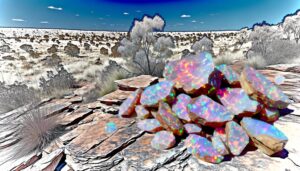Fire Opals Found in 7 Countries
You'll find fire opals primarily in Mexico, where geothermal activity in Querétaro and Jalisco creates these gems. Australia's Lightning Ridge and Coober Pedy also produce significant quantities, contributing 95% of global opal supply.
In the U.S., Nevada's Virgin Valley and Oregon's Opal Butte are key sources. Brazil's Pedro II region yields high-quality fire opals shaped by iron oxide.
Honduras offers rich deposits in La Ceiba and Gracias. Ethiopia and Indonesia are notable sources due to unique geological formations.
Additionally, Guatemala and Peru produce vivid and striking fire opals. Discover more about these fascinating locations and their impact on opal mining.
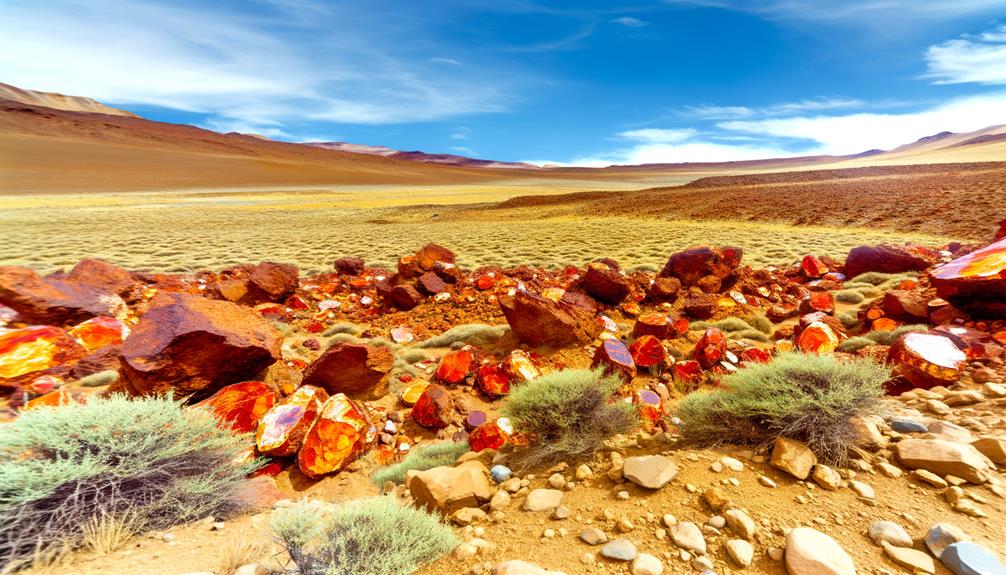
Key Takeaways
- Fire opals are found in Mexico, notably in Querétaro and Jalisco.
- Australia, especially Lightning Ridge and Coober Pedy, is a major source of fire opals.
- The United States has significant fire opal deposits in Nevada's Virgin Valley and Oregon's Opal Butte.
- Brazil's Pedro II region is renowned for high-quality fire opals.
- Ethiopia, especially Wegel Tena and Delanta, is a prominent fire opal mining area.
Mexico's Volcanic Origins
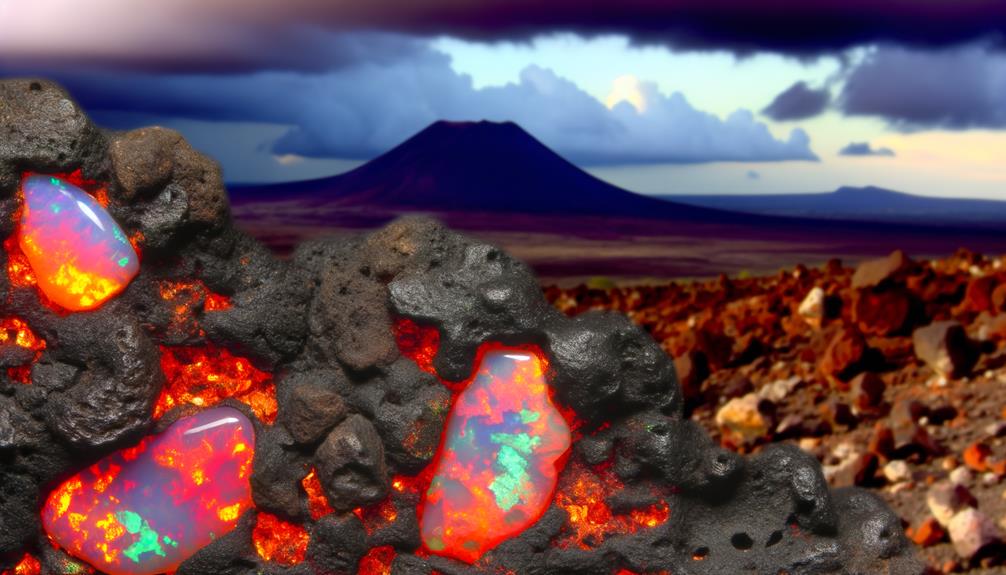
Mexico's volcanic origins are intricately linked to the formation of fire opals, with geothermal activity providing the necessary conditions for their creation. You'll find that igneous processes generate high temperatures and pressures, facilitating silica deposition within fissures.
The cooling rates and mineral content influence the vivid color spectrum of fire opals. Specifically, the states of Querétaro and Jalisco are prime locations, where volcanic tuff layers contain significant opal deposits. Studies indicate that these regions produce fire opals with a water content of about 3-10%, contributing to their unique play-of-color phenomenon.
Geological surveys reveal that the hydrothermal fluids percolate through volcanic ash layers, creating an ideal environment for opal formation. This precise interplay of conditions makes Mexico a key source.
Australian Deposits
Australia's opal fields, particularly those in Lightning Ridge and Coober Pedy, are renowned for producing high-quality fire opals with distinct play-of-color. These regions are geologically rich, with opal formations occurring in sedimentary rock layers. The Lightning Ridge deposits are especially noted for their high silica content, contributing to the vibrant hues and exceptional clarity of their fire opals.
You'll find that Coober Pedy, known as the 'Opal Capital of the World,' offers significant quantities of fire opals embedded in sandstone formations. Mining techniques here are highly advanced, utilizing tunneling and shaft sinking to access deeper layers.
Data indicates that Australia contributes nearly 95% of the world's opal supply, with fire opals being a significant portion. The regions' deposits are vital for the global gem market.
U.S. Fire Opal Sites

The United States boasts several notable fire opal sites, particularly in Nevada and Oregon, where geothermal activity and volcanic deposits contribute to the formation of these vibrant gemstones.
In Nevada, Virgin Valley is a prime location, known for its opals with vivid, fiery hues. It's estimated that the region produces over 80% of the country's fire opals.
Meanwhile, Oregon's Opal Butte is renowned for its high-quality fire opals, often displaying exceptional play-of-color. These sites benefit from silica-rich volcanic ash layers and hydrothermal fluids, which facilitate opal formation.
If you're researching American fire opals, focus on these geological hotspots known for their significant yield and superior gemological characteristics.
Brazil's Hidden Gems
You'll find some of the most remarkable fire opals in the mines of Pedro II, Brazil.
The region's unique geological conditions contribute to the high-quality and vibrant hues of these gems.
However, mining operations face significant challenges, balancing operational costs with the potential rewards of unearthing these prized opals.
Mines in Pedro II
Pedro II in Brazil is renowned for its high-quality fire opal deposits, which are a significant contributor to the global gemstone market. You'll find that the mines in this region produce fire opals with exceptional transparency and vibrant color play. The average yield from these mines is around 60% gem-quality stones, with a notable percentage exhibiting the coveted cherry-red hue.
Extraction techniques involve both open-pit and underground mining, guaranteeing minimal environmental disruption. Advanced geological surveys and precise drilling methods enhance the efficiency and safety of operations. The local workforce, highly skilled in gemstone extraction and processing, ensures that each fire opal meets stringent quality standards, making Pedro II a pivotal hub in the gemstone industry.
Unique Geological Conditions
Beyond the renowned mines in Pedro II, Brazil's unique geological conditions play a pivotal role in creating the diverse and vibrant fire opals found throughout the region. The region's volcanic activity contributes substantially to the formation of these opals. When silica-rich waters infiltrate volcanic ash layers, they precipitate silica spheres, leading to opal deposits.
High-temperature gradients and rapid cooling rates in Brazil's geologic formations ensure diverse opal coloration. Additionally, the presence of iron oxide imparts the characteristic fiery hues. Geochemical analysis reveals that trace elements such as aluminum and magnesium also influence color intensity.
Brazil's specific combination of volcanic activity, mineral-rich waters, and rapid cooling conditions establishes an ideal environment for fire opal genesis, distinguishing them from opals found elsewhere.
Mining Challenges and Rewards
Exploring the mining of Brazil's fire opals involves contending with complex geological formations and fluctuating market demands, which present both substantial challenges and significant rewards.
You'll face difficult extraction processes due to Brazil's diverse stratigraphy, necessitating advanced drilling techniques and specialized equipment. Additionally, irregular opal deposits mean inconsistent yields, impacting profitability.
However, the rewards are equally compelling. High-quality fire opals from Brazil command premium prices, driven by their unique color play and rarity. Market data indicates a steady rise in global demand for these gems, suggesting lucrative opportunities for successful miners.
Maneuvering these challenges with precise planning and robust investment can yield significant returns, making the endeavor both a high-risk and high-reward venture.
Honduras Discoveries
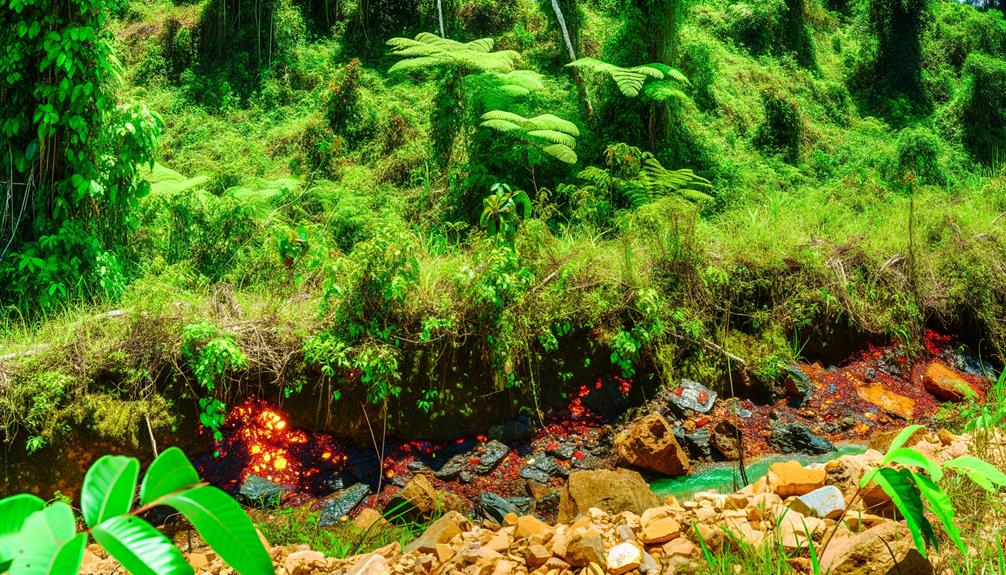
You'll find that Honduras has a rich history of fire opal extraction, primarily from ancient mining sites. These locations are characterized by their unique geological formations, contributing to the distinctiveness of Honduran fire opals.
Historical data indicates that the mineralogical composition here differs notably from other regions, making it a focal point for geological studies.
Ancient Mining Sites
In Honduras, significant fire opal deposits have been unearthed at ancient mining sites, revealing the region's rich geological history. These sites offer invaluable insights into early mining techniques and the geological conditions that fostered opal formation.
Detailed excavations have identified three primary ancient mining areas:
- La Ceiba: Known for extensive fire opal veins, it provides evidence of sophisticated early extraction methods.
- Gracias: This site yields high-quality opals, indicating advanced geological understanding by ancient miners.
- San Pedro Sula: Offers a variety of opal types, showcasing the diversity of mineralogical conditions.
These sites not only highlight historical mining prowess but also contribute to contemporary geological studies, emphasizing the region's significance in the global opal market.
Unique Geological Formation
The geological formations in Honduras, characterized by their unique mineral compositions and thermal activities, have led to the creation of some of the world's most vibrant fire opals.
You'll find that the Honduran deposits are primarily located in volcanic regions where silica-rich, hydrothermal fluids interact with rhyolitic lava. This interaction facilitates the precipitation of silica spheres, forming opal.
Data indicates that these deposits exhibit a higher concentration of iron oxides, contributing to the vivid red and orange hues typical of fire opals. Geological surveys have documented that the ideal conditions for fire opal formation in Honduras occur at depths of 20-30 meters.
This precise combination of geological factors makes Honduras a significant locale for high-quality fire opal extraction.
Ethiopia's Fiery Fields
Ethiopian fire opals, primarily sourced from the Wollo Province, boast remarkable play-of-color and unique geological characteristics. You'll find these opals in volcanic rock formations that provide the ideal conditions for their creation. Their vibrant hues and transparency make them highly sought after in the gemstone market.
Consider the following data for Ethiopian fire opals:
- Geological Formation: They're formed in rhyolitic volcanic rock, contributing to their distinct mineral composition.
- Play-of-Color: These opals exhibit a spectrum of colors, including vivid reds, oranges, and yellows, due to the diffraction of light.
- Extraction Zones: Major mining areas include Wegel Tena and Delanta, known for producing high-quality fire opals.
Understanding these factors underscores the significance of Ethiopian fire opals in gemology.
Indonesian Finds
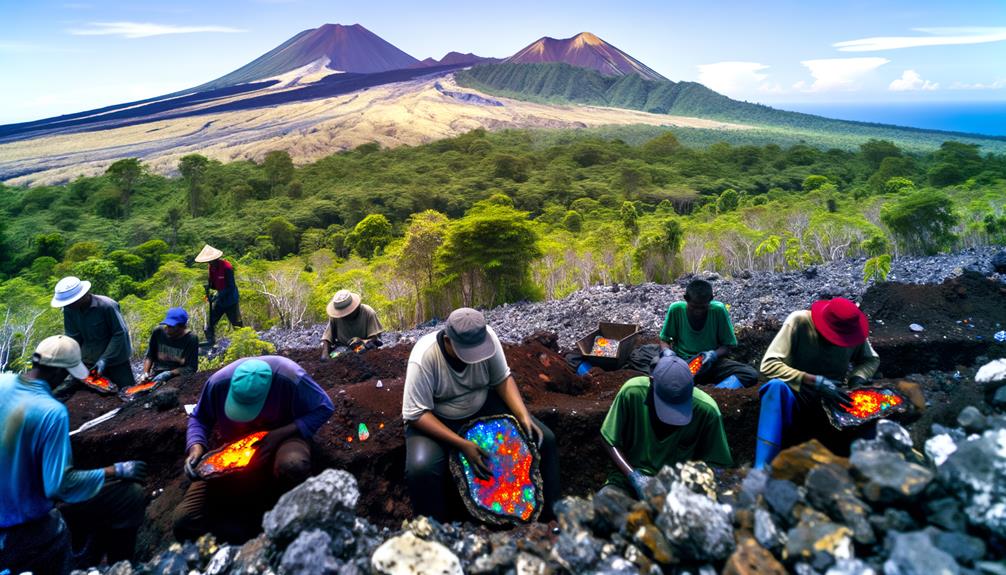
Discover the remarkable fire opals of Indonesia, primarily mined from the geothermal terrains of Java and Sumatra, which exhibit a unique blend of vibrant colors and exceptional clarity. You'll find these opals are characterized by their unique geological formation, influenced by volcanic activity. The high silica content and rapid cooling processes contribute to the opals' intense hues and transparency.
| Location | Color Spectrum | Clarity Grade |
|---|---|---|
| Java | Red to Orange | High |
| Sumatra | Yellow to Red | Medium |
| East Kalimantan | Orange to Yellow | High |
| Sulawesi | Red to Yellow | Medium |
These fire opals are not only aesthetically pleasing but also possess significant mineralogical properties, making them highly sought after in gemological circles.
Guatemalan Treasures
Journey to the rugged highlands of Guatemala, where fire opals showcase a mesmerizing array of colors and exceptional luminescence, thanks to their unique formation processes in volcanic ash deposits. These opals are renowned for their vivid hues, ranging from deep reds to brilliant oranges. Their quality is determined by their:
- Transparency: High clarity enhances the gem's value.
- Color Play: Intense, uniform color distribution indicates superior stones.
- Carat Weight: Larger stones are rarer and hence more valuable.
Guatemalan fire opals form in rhyolitic volcanic deposits, creating unique silica structures that trap moisture, resulting in their characteristic glow. You'll find that these gems are highly sought after by collectors and jewelers for their unparalleled beauty and rarity.
Nevada's Opal Mines

You'll find Nevada's opal mines primarily in the Virgin Valley, known for its high-quality fire opals.
Significant discoveries include the Roebling Opal, which weighs 2,585 carats.
These mining locations are integral to both commercial and amateur gem collecting.
Mining Locations in Nevada
Mining for fire opals in Nevada focuses on the Virgin Valley, celebrated for its top-notch opal reserves. You'll come across various prominent mining spots here, each presenting distinct chances for extraction.
Noteworthy locations include:
- Rainbow Ridge Opal Mine: Recognized for its productive mining region, yielding top-quality opals.
- Royal Peacock Opal Mine: This location allows paid excavation, enabling you to unearth your own opals.
- Bonanza Opal Mine: Showcasing various opal varieties and providing guided tours elucidating the geology.
These mining sites employ advanced methodologies like open-pit mining and hydraulic sluicing to optimize production. Make sure you comprehend the geological formations and stratigraphy of the Virgin Valley to effectively pinpoint opal-rich areas.
Famous Opal Discoveries
Frequently, the Virgin Valley's opal mines yield extraordinary specimens, with some of the most famous discoveries garnering significant attention from both geologists and gem enthusiasts.
You'll encounter the 'Roebling Opal,' a remarkable 2,585-carat black opal, renowned for its vibrant play-of-color.
In addition, the 'Gingko Tree' opal, a fossilized tree limb replaced by vivid opalization, showcases nature's transformative processes.
Data collected from these mines indicate a high prevalence of precious opals, including black, crystal, and fire opals.
Precise measurements of these opals' refractive indices (ranging from 1.37 to 1.52) and specific gravity values (between 1.98 and 2.20) provide critical insights into their quality and formation.
Your exploration here will reveal the geological marvels hidden within Nevada's opal-rich strata.
Peruvian Fire Opals
In the Andean regions of Peru, fire opals are sourced primarily from volcanic deposits enriched with high silica content. These opals exhibit a vibrant orange to red hue due to trace amounts of iron oxide.
When evaluating Peruvian fire opals, you should focus on three critical factors:
- Color Saturation: High-quality specimens exhibit intense, uniform coloration.
- Transparency: Superior fire opals possess a clear, translucent appearance.
- Cut and Polish: Precision cutting and professional polishing enhance the gem's natural brilliance.
Peruvian fire opals are highly valued for their striking visual properties and geological uniqueness. Their formation involves hydrothermal processes, where silica-rich solutions precipitate in volcanic cavities.
Understanding these factors ensures you can accurately assess the quality and value of Peruvian fire opals.
African Locations
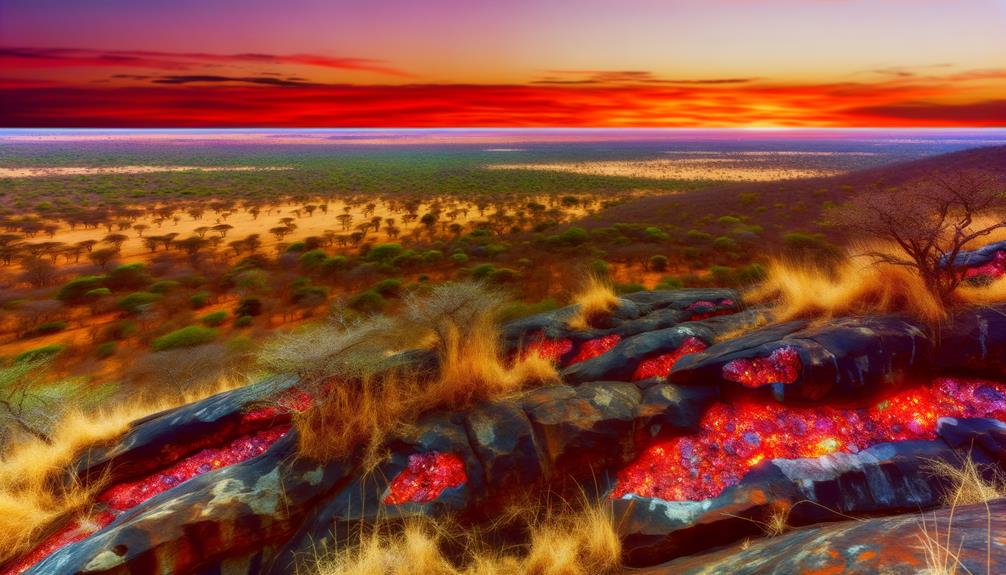
You'll find some of the world's most vibrant fire opals in Ethiopia, specifically sourced from the Wollo and Mezezo regions. These opals exhibit an extraordinary play-of-color, primarily due to their high water content, which can range from 3% to 21%.
The geological formations in these areas contribute to the opals' unique silica structure. In Wollo, mining depths frequently reach up to 60 meters, with strict extraction protocols ensuring minimal environmental impact. Mezezo's deposits are known for their diverse color spectrum, from vivid oranges to intense reds.
Both regions employ advanced gemological techniques to assess opal quality, focusing on attributes like translucency and hue uniformity. As a professional, you'll appreciate the meticulous craftsmanship involved in procuring these gems.
European Occurrences
Europe boasts several notable fire opal deposits. In Hungary's Cserhát Mountains, the opals are renowned for their striking clarity and vibrant hues. These deposits exhibit an exceptional play of color due to the geological conditions.
To better understand European fire opal occurrences, consider the following:
- Hungary's Cserhát Mountains: Known for high-quality fire opals with intense red and orange colors.
- Slovakia's Dubnik Mine: Yields opals with distinctive flame-like patterns and high transparency.
- Romania's Transylvania Region: Produces opals with a unique combination of translucency and fiery coloration.
Rare Global Spots
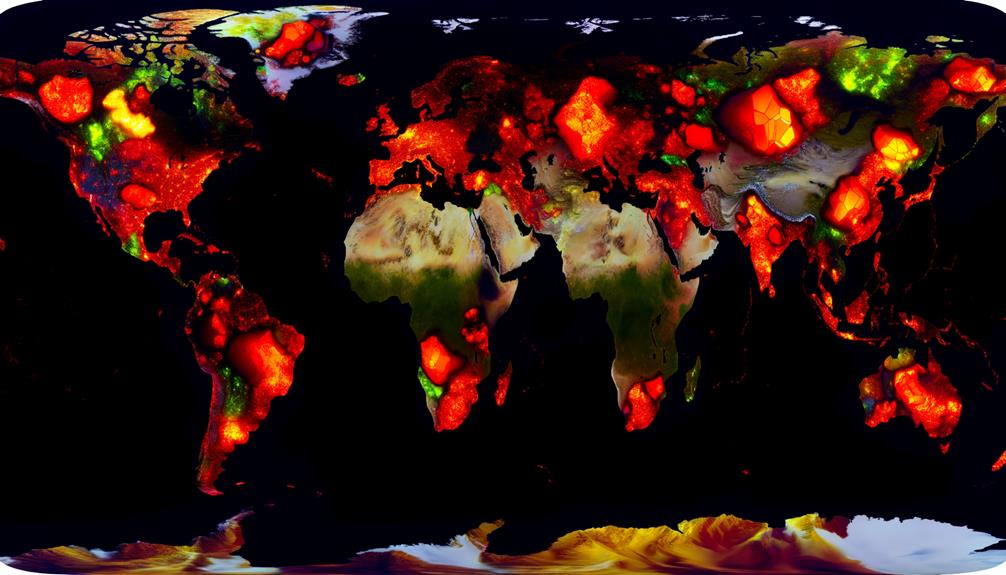
While exploring rare global spots for fire opals, you'll find that Ethiopia's Wegel Tena region offers some of the world's most vibrant specimens. The opals from this region are renowned for their intense play-of-color and clarity. Another notable location includes the Menz Gishe District, where you can discover opals with deep, fiery hues.
Here's a quick overview of rare fire opal locations:
| Region | Country | Notable Features |
|---|---|---|
| Wegel Tena | Ethiopia | Intense play-of-color, clarity |
| Menz Gishe District | Ethiopia | Deep, fiery hues |
| Querétaro | Mexico | Bright, transparent fire opals |
| Virgin Valley | USA (Nevada) | Unique hydrophane properties |
These regions are pivotal for understanding the geological diversity and unique properties of fire opals.
Conclusion
In your journey through the fiery depths of the Earth, you've uncovered the secrets of fire opal deposits from Mexico to Europe. Each region offers its unique geological marvels, shaped by volcanic activity and mineral compositions.
By understanding these intricate processes, you'll appreciate the rarity and beauty of fire opals even more. This gemstone's global footprint, though scattered like stars, forms a rich tapestry of Earth's dynamic history and mineral wealth.



